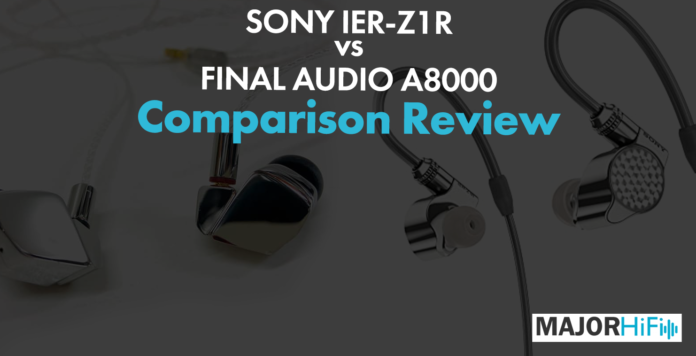Recently, I finally got to listen to the Sony IER Z1R and share my experience with it. When I was listening to them, I kept thinking about the Final Audio A8000 since they are both IEMs that go for the same price. Sony’s model is definitely more popular than the one from Final Audio, but I find that they work as good companions to one another, and complement each other’s qualities in some cases. Let’s compare them and see which IEM has the sound you might be looking for.
What You Get
| Final Audio A8000 | Sony IER Z1R |
|
|
Look and Feel
The IER and A8000 have a similar silver design that gives both IEMs a stylish finish, but in terms of build, they couldn’t be any different. When I reviewed the IER, one of my biggest criticisms of it was its unnatural feel, mainly due to its large circular housing. The fit of the IER isn’t the most comfortable listening experience by any standard, and when compared to the satisfying ergonomic shape of the A8000 the difference is night and day. Final Audio has used this design in their B series and A series, to great success, and has no reason to change any time soon. For Sony, their IEM designs leave a lot of room for significant improvement.
Design
When it comes to designing the interior components, the IER and A8000 take different paths to arrive at their desired sound signature. The IER uses a hybrid system that incorporates a dual 12mm dynamic drive and a single balanced armature with an acoustic tube chamber unit for more dense signal output. The A8000 utilizes just a single dynamic driver but uses a beryllium diaphragm for superior transparency and speed. It also uses four separate chambers in an attempt to significantly reduce resonance.
Soundstage
Both of these IEMs showcase spatial excellence, delivering some of the best soundstages IEMs have to offer. The models play two sides of the same level spectacular IEM imaging and display their signature in ways that complement each other. I’ve always been big on the A8000 due to its excellent accuracy and precision within its stereo field. It takes musicality and performs it on a level that is instantly recognizable in terms of localized positioning and layering. Sony’s model operates much differently than the A8000, opting for a much more theatrical soundstage that still adheres to spatial clarity.
The IER’s grandiose imaging puts it on a completely different sound spectrum than the A8000. Its level of scale is a lot more extended, offering depth and fullness to the imaging in a realistic manner. Everything feels powerful yet controlled in the IER and that’s part of what makes it so unique in terms of its soundstage. At the end of the day, if you’re looking for purity and reliability, there’s not a whole lot that can compare to the A8000, but if you’re in it for the more dramatic elements IEMs can deliver, the IER will deliver on that.
Low End
While the A8000 definitely has plenty to offer in the bass range, there is a reason bass-heads seek out the IER as their endgame defining IEM. The low-end on the Sony’s is massive compared to the A8000, which still holds a significant amount of depth and warmth, but the IER outperforms here in terms of texture and speed. The smooth vibrations and colossal punch are incredible, and it doesn’t bloat or take anything away from other ranges of frequency. In comparison, the A8000 is a lot more easy-going but still displays impressive definition and accentuation in its timbre. It shares a respectable transient response, but its quickness is easily outdone by the IER.
Mids
By the time the midrange comes around, the IER starts to lose some of its flavor, and the A8000 starts to gain some. When it comes to detail, the A8000 outshines the IER with its engaging musicality and coloration, especially in the upper mids. Vocals shine on the A8000, and while the IER has some good clarity in this range as well, it doesn’t contain the same level of consistency as the A8000. With the A8000, you get an edge to the midrange that the IER doesn’t compete with, and instead lets other textures and tones resonate much more definitely to make up for missing detail in this region.
Highs
The treble on the IER is heightened that’s to its imaging and soundstage, but just as the lows were its greatest showcase, the A8000 excels in the highs. With the A8000, you get a good amount of bite in the high frequencies, giving certain elements a metallic emphasis that can be sparkly and pleasant. The IER plays its highs a lot safer, giving its frequencies a softer resonance that isn’t as defined as the A8000. It works for the kind of sound signature it is going for but compared to the glistening qualities of the A8000 it can seem like something is missing.
Summary
The IER Z1R and A8000 have their own qualities that feel opposite from one another. While the A8000 has detailed mids and highs, the IER has the imaging and bass impact. That’s really what it comes down to besides getting past the IER’s bulgy housing design and unnatural fit.
The Sony IER Z1R and Final Audio A8000 are available at Audio46.
Compare the ranking of various headphones, earbuds and in-ear monitors using our tools.
Discuss this, and much more, over on our forum.
---MAJORHIFI may receive commissions from retail offers.















